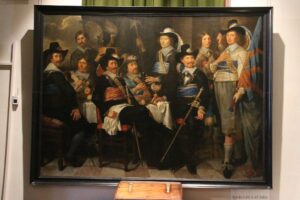The Dutch Golden Age in art is a period of unparalleled creativity and mastery that transformed the Netherlands into a powerhouse of artistic innovation.
This era, spanning the 17th century, saw Dutch society flourish in wealth and culture, giving rise to some of the most revered masterpieces in art history.
We’ll explore how this golden period came to be and the legendary artists who defined it.
From Rembrandt’s evocative portraits to Vermeer’s tranquil domestic scenes, we’ll jump into the works that continue to captivate us centuries later.
Origins Of The Dutch Golden Age
The seeds of the Dutch Golden Age were sown during a period of unprecedented economic growth.
It’s the 17th century and the Dutch Republic is becoming a powerhouse with its shipping, trade, and banking sectors leading the way.
This economic boom provides the fertile soil from which a cultural renaissance can grow.
Our focus shifts to the bustling cities of Amsterdam and Haarlem.
These urban centers become hubs for artists as the newfound wealth creates a surge in demand for art.
The middle class – wealthy merchants and traders – start to see art as a status symbol.
They’re commissioning works for their homes, creating a vibrant market for artists to thrive.
Dutch artists seize the opportunity to break from traditional religious subjects, instead pioneering genres such as:
- still life – capturing the beauty of everyday objects – Landscape – depicting the Dutch countryside,
- Genre painting – scenes of everyday life.
We must note that the political climate played a crucial role in shaping the character of Dutch art.
The Netherlands, following its independence from Spanish rule, didn’t have a monarchy or church dictating artistic themes.
This political independence allows artists like Rembrandt and Vermeer to explore human nature, light, and space in their own groundbreaking ways.
Scholars often point to a combination of economic prosperity, political freedom, and social change as the perfect storm that gave rise to the Dutch Golden Age in art.
This movement reflects an era where the Dutch not only dominated global trade but also left an indelible mark on the history of art, influencing generations to come.
Socioeconomic Factors Contributing To Artistic Flourishing
The blossoming of Dutch art during the Golden Age was inextricably linked to the socioeconomic dynamics of the period.
A notable shift toward capitalism saw the Dutch Republic emerge as a powerhouse in commerce.
With Amsterdam and Haarlem as thriving centers of trade, wealth flowed into the region, setting the stage for an unparalleled investment in the arts.
This newfound prosperity meant that not only the nobility but also the burgeoning middle class could afford to indulge in the luxury of collecting artwork.
Entrepreneurial spirit fueled a unique art market characterized by:
- A surge in demand for personal and household art collections,
- Art fairs and auctions becoming commonplace,
- Artists establishing studios and producing works with potential buyers in mind.
Artists were no longer exclusively commissioned by the Church or aristocracy; they now catered to merchants and traders who sought scenes relation to their secular lives.
This shift allowed painters to explore a wider range of subjects, including the landscapes and portraits that today epitomize the Dutch Golden Age.
So, genres that depicted everyday life gained prominence, leading to an explosion of genre painting, still lifes, and cityscapes.
The social milieu of the Dutch Republic also played a critical role.
Relative religious tolerance and intellectual freedom fostered an environment where creativity could thrive.

Notable artists like Rembrandt and Vermeer flourished in this period, producing works such as The Night Watch and Girl with a Pearl Earring.
These masterpieces not only reflect the artistic prowess of their creators but also encapsulate the essence of a society rich in both affluence and cultural vibrancy.
Our in-depth understanding of film and the broader canvas of creative arts can draw parallels between this historical artistic explosion and the contemporary cinematic landscape.
Just as the Dutch artists capitalized on their socioeconomic climate, modern filmmakers often reflect and respond to today’s cultural and economic realities, pushing boundaries and innovating within their craft.
The Rise Of The Dutch Republic And Its Impact On Art
As the Dutch Republic ascended economically and politically, the art world witnessed a transformative period.
Amsterdam’s emergence as a financial hub led to an increased patronage of the arts.
Wealth flowed not just into trade and business but also into the hands of artists, who now enjoyed the financial support and creative freedom to pursue art in new and exciting directions.
The dynamism of the Dutch Republic’s society was mirrored in the artworks produced during this time.
With the patronage system expanded beyond the Church and nobility, artists explored a broader range of subjects and themes.
Secular portraiture, still lifes, and landscapes came into prominence, catering to the tastes and interests of the burgeoning merchant class.
- The accessibility of art increased – now, even middle-class citizens could commission or purchase art.
- Shifts in subject matter – artists depicted daily life, local scenery, and ordinary people.
- Technical innovations – the use of light and shadow became more prominent, adding depth and realism to the paintings.
This era marked a significant departure from the traditional art formats that were once dominated by religious and royal commissions.
Painters like Rembrandt and Vermeer perfected techniques that captured the essence of their subjects with remarkable detail and emotion.
The artwork of the Dutch Golden Age not only reflects its society’s values but also pushes the boundaries of what art could represent at the time.
The influence of the Dutch Golden Age is undeniable in the realm of filmmaking as well.
Modern directors often draw on the era’s techniques, such as the dramatic play of light and shadow, to enhance the visual storytelling in films like Girl with a Pearl Earring, which directly references Vermeer’s famous work.
Just as art collectors of the 17th century celebrated the mastery of these Dutch artists, today’s film enthusiasts revere directors who can harness similar techniques to evoke powerful emotions on screen.
Masterpieces Of The Dutch Golden Age
The Dutch Golden Age bestowed upon the world a treasure trove of art that has left an indelible mark on history.
Among these jewels is Rembrandt’s The Night Watch, a revolutionary painting that details the complexity of motion and emotion in a way that had never been seen before.
The intricate play of light and the dynamism of the composition have inspired countless filmmakers in their quest to capture the essence of life on screen.

In the realm of quiet introspection and stunning detail, Johannes Vermeer’s Girl with a Pearl Earring is another paragon from this era.
This work is exemplary of Vermeer’s luminous style and has significantly influenced the lighting techniques used in modern cinematography.
Besides, the impact of Dutch Golden Age art is not limited to history; its influence pervades through other key pieces:
- Frans Hals’ The Laughing Cavalier – the spirited portrait conveys a sense of immediacy and character insight that many film characters aspire to emulate.
- Jan Steen’s The Feast of Saint Nicholas – an intimate depiction of family life and celebration that echoes in the genre of family drama films.
- Jacob van Ruisdael’s View of Haarlem with Bleaching Grounds – with its vast skies and meticulous attention to natural landscapes, it inspires scenic designs and backdrops in the world of filmmaking.
These masterpieces exemplify the rich storytelling and technical prowess that the Dutch Golden Age has contributed to the arts.
Our understanding and appreciation of light, color, and narrative complexity in film owe much to the techniques and themes explored by these renowned artists.

The Influential Artists Of The Era
During the Dutch Golden Age, a constellation of master artists emerged, redefining art with their innovative styles and techniques.
Among them, Rembrandt van Rijn stood out as a titan of portraiture and religious scenes.
His use of chiaroscuro and deep psychological insight in works like The Night Watch brought a new depth to the representation of human experience on canvas.
Another luminary, Johannes Vermeer, captivated with his serene interiors and meticulous attention to light and detail.
His paintings like Girl with a Pearl Earring are celebrated for their sublime tranquility and the remarkable use of light, which filmmakers have sought to emulate in their visual storytelling.
Artists we must acknowledge:
- Frans Hals – Known for his lively and spontaneous portraits,
- Jan Steen – Master of genre scenes depicting everyday life,
- Jacob van Ruisdael – His landscapes imbued with dramatic skies and emotive natural scenery.
These artists pushed boundaries and embraced a spirit of innovation that has trickled down through the centuries.
Their contributions went beyond mere representation; they infused their art with a kind of narrative complexity and emotional resonance that continues to inspire across mediums.
In cinema, the influence is unmistakable as directors draw upon the visual language developed during this rich period of artistic flourishing.
What Is Dutch Golden Age In Art – Wrap Up
We’ve explored the remarkable era of the Dutch Golden Age and its enduring legacy in the art world.
The innovative spirit and masterful techniques of the artists from this period have set a benchmark for artistic excellence.
Their work continues to inspire and influence creators across the globe, ensuring that the Dutch Golden Age remains a touchstone for those seeking to understand the depth and beauty of human expression through art.
Frequently Asked Questions
What Was The Dutch Golden Age And How Did It Impact The Art World?
The Dutch Golden Age was a period in the 17th century characterized by great wealth, cultural development, and prosperity in the Netherlands.
It had a profound impact on the art world through the pioneering work of artists like Rembrandt and Vermeer who introduced innovative styles and techniques that transformed the way human experiences and emotions were depicted on canvas.
Who Were The Most Influential Artists Of The Dutch Golden Age?
The most influential artists of the Dutch Golden Age include Rembrandt van Rijn, known for his dramatic use of light and shadow; Johannes Vermeer, famous for his serene scenes of domestic life and attention to detail; as well as Frans Hals, Jan Steen, and Jacob van Ruisdael, who were renowned for their unique contributions to portraiture, genre scenes, and landscapes, respectively.
What Artistic Techniques Were Pioneered During The Dutch Golden Age?
During the Dutch Golden Age, artists such as Rembrandt and Vermeer pioneered the use of chiaroscuro, a technique involving strong contrasts between light and dark to create a sense of volume and depth in painting.
They also focused on fine details and creating realistic representations of materials and textures, which contributed to the intimate and lifelike quality of their work.
How Do The Works Of Dutch Golden Age Artists Influence Contemporary Art And Filmmaking?
Artists from the Dutch Golden Age influence contemporary art and filmmaking by providing a strong foundation in realism, attention to detail, and use of light and shadow.
Modern-day artists and filmmakers often draw inspiration from these elements to enhance visual storytelling and create vivid and compelling narratives.
The Golden Age’s emphasis on capturing the nuances of the human experience continues to resonate in today’s creative works.


